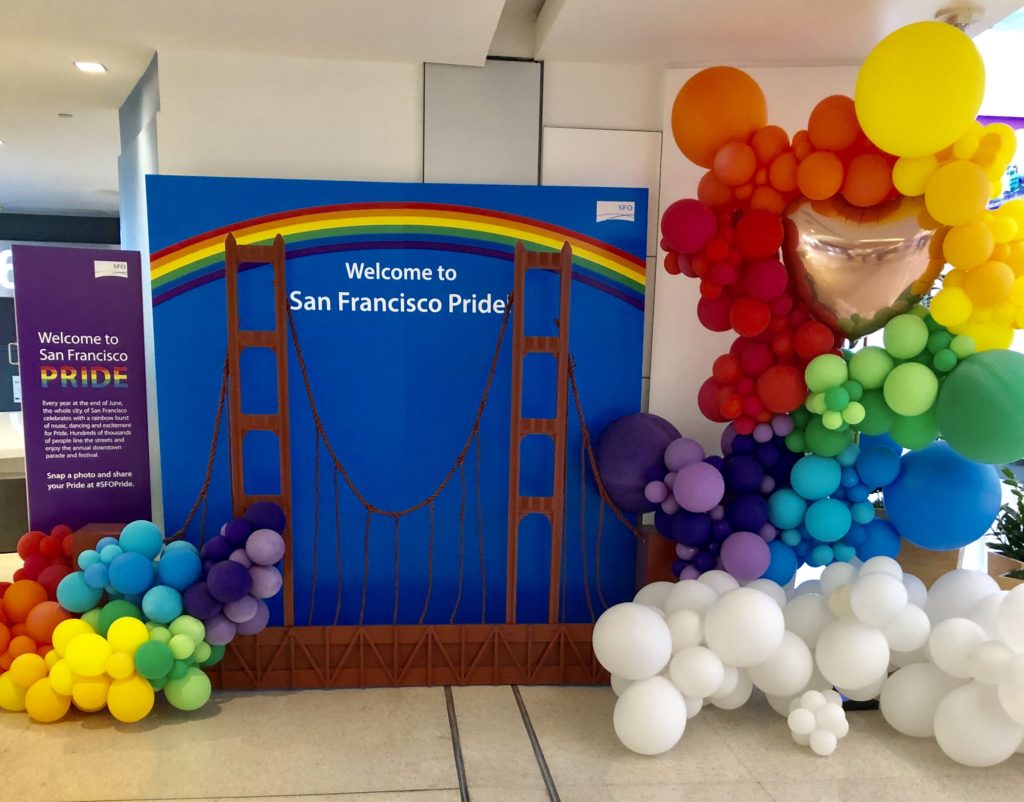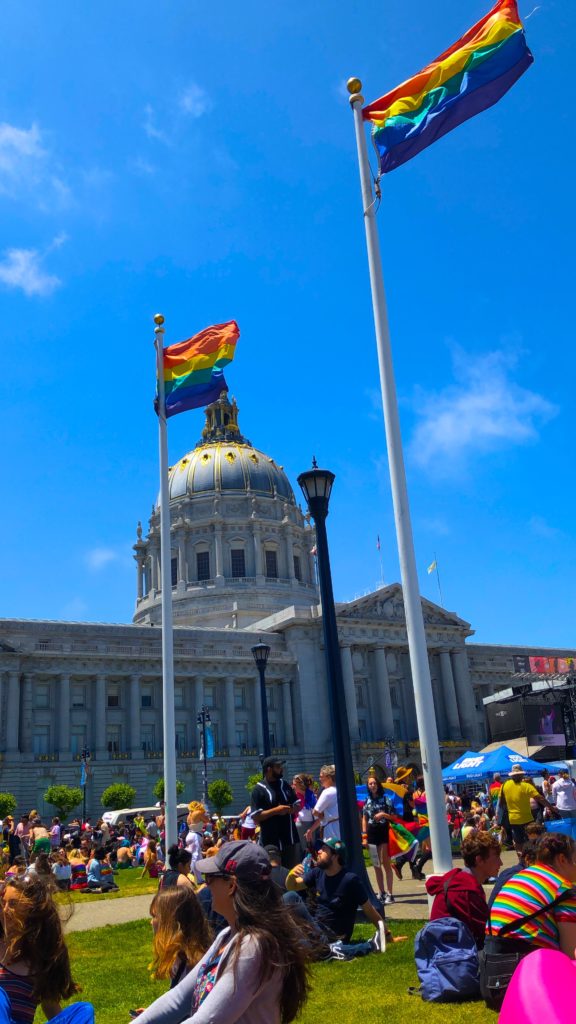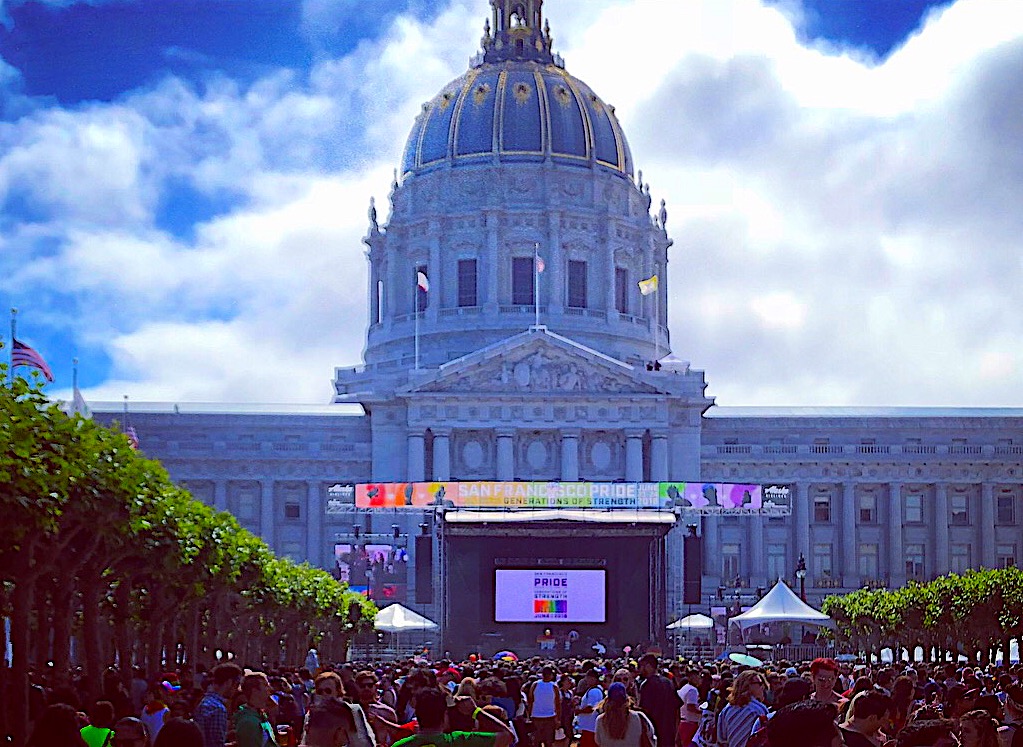While the summer is barely getting started, the official Pride month has finally come to a close. DTLA Proud may still be coming in August, but the 50th anniversary of the 1969 Stonewall Riots was this past weekend, which was the catalyst for the first Pride the following year. L.A.’s Pride celebration was three weeks ago, but two of the biggest Pride celebrations in the country were held this past weekend on the actual anniversary of Stonewall: New York City and San Francisco. World Pride took over NYC for the anniversary, resulting in one of the biggest turnouts in Pride history (4-5 million). But just 400 miles north of L.A., I attended San Francisco Pride, which may not have been as big as NYC’s but is still the biggest Pride celebration on the West Coast. For those who have never been, I wanted to give a quick rundown of just how different it is from L.A. Pride.
First, the sheer size is pretty different. L.A. Pride may be getting bigger and bigger every year, but so is San Francisco Pride: turnout estimates for this year’s L.A. Pride was estimated at “hundreds of thousands” while San Francisco’s was “almost 1 million.” And while L.A. has struggled with crowd management, San Francisco seems to have a better handle on it. There were long lines to get into some of the Festival entrances, but if you just went a few blocks further you could get in to an entrance with practically no line. It was also pretty easy to get a decent spot to see the parade no matter what time you got there.

(Michael Cooper)
Perhaps the crowd issue is helped by the fact that San Francisco Pride is mostly spread out into 3 areas: the Castro, which is where most LGBTQ bars are found, Mission Dolores Park, which is where thousands gather before the Dyke March (more on that later) and then the festival and parade at the Civic Center. In L.A., on the other hand, everything is condensed into West Hollywood (the bars, the parade and the festival). When you have everyone in the city congregating into one neighborhood as opposed to three, the result is more crowds and more lines. L.A. is much more spread out than San Francisco, and the closest gayborhood to WeHo would be Silver Lake or the Valley, which is not as close as the three neighborhoods in San Francisco for people to bounce between the events.
My favorite part of San Francisco Pride is the Dyke March on Saturday evening, which is preceded by a giant party in Dolores Park. L.A.’s Dyke March is usually held on Friday night and definitely doesn’t have the same community spirit beforehand, probably because most people are at work earlier in the day. Having the Dyke March on Saturday instead solves that problem and gives way to the gathering in the park. Dolores Park is huge (almost 16 acres) and thousands of people spread out all over sitting in the sun, drinking, socializing and just being together as a community. Then at 5 p.m., the Dykes on Bikes lead the march that goes from Dolores Park to the Castro (some continue the march back to Dolores). People who live on the march route are throwing beads out of their windows, holding up signs on their roof or setting up speaker systems outside their buildings to play music. I’m not a “dyke” myself but I’m happy to support others in the community, and so it seems is the rest of San Francisco. This level of involvement simply doesn’t exist in L.A., as much as I wish it did.

(Michael Cooper)
Another thing to note is that the location of San Francisco’s parade and festival at the Civic Center is right next to the rougher Tenderloin area. While the Tenderloin has been improving (and also gentrifying), having Pride in a rougher area is definitely a big difference from the WeHo scene in L.A., which is pretty posh. The number of homeless, mentally ill and drug dealers hanging out around the festival and parade in San Francisco can be a bit off putting for some. For example, I went to famous San Fran drag queen Juanita MORE!’s Pride party on Sunday, which took place about six or seven blocks from the festival and provided a juxtaposition of citizens that was definitely different from a walk to Pride in WeHo.
Juanita’s party, by the way, is an annual Pride tradition that is completely not-for-profit; it picks a new LGBTQ charity every year to donate to. This year, the party raised over $133,000 for the San Francisco GLBT Historical Museum and Archives. While L.A. is steeped in LGBTQ history (such as the Black Cat Tavern protests in Silver Lake that occurred two years before Stonewall), San Francisco’s gay community just seems slightly more historic, from the LGBTQ sailors discharged for homosexuality and dumped there after World War II to Harvey Milk to the city’s drag protest group the Sisters of Perpetual Indulgence (there is chapter here as well). There’s a good chance you can run into someone who played a major role in LGBTQ history in a Castro bar (I ran into activist Cleve Jones during last year’s Pride). Sure, you may run into a celebrity at L.A.’s Pride, but it somehow doesn’t seem to carry the same gravitas. Even traditions like Juanita’s party seem to be lacking in L.A., and heaven forbid something in L.A. would be 100% not-for-profit.
Which brings me to perhaps the biggest difference between Los Angeles and San Francisco’s Prides: San Francisco’s festival is free! Of course they don’t have the talent lineup that L.A. Pride has gotten since it’s placed more focus on the music aspect and turned into “Gaychella,” but San Francisco has more stages (albeit smaller ones). And there’s more to do inside the festival too — more booths, more places to dance, more places to sit in the sun and even a leather alley.

(Michael Cooper)
In recent years L.A. Pride has become very Hollywood, with a $50 price tag to attend both days and an option to buy VIP tickets to gain access to exclusive bars, bathrooms and standing room. As I wrote in my recap of L.A. Pride, this defeats part of the purpose of Pride; there really shouldn’t be any VIPs at Pride because the very point of Pride is to equalize our community and to celebrate everyone. And frankly San Francisco does a lot better job at this than L.A. does.
Ultimately though, no matter how different San Francisco’s Pride may be from Los Angeles,’ the fact that Pride celebrations across the country are getting bigger means that more LGBTQ people are celebrating ourselves out and proud, as are our allies. I will continue to attend L.A. Pride every single year for that reason alone. But I encourage Angelenos to make the trek up to the Bay Area and experience San Francisco Pride at least once as well. Together, with our Northern brothers and sisters (and everyone in between), we can show those on the East Coast what it means to be proud in California. Now excuse me while I get some much needed Post-Pride rest.
Advertising disclosure: We may receive compensation for some of the links in our stories. Thank you for supporting LA Weekly and our advertisers.

